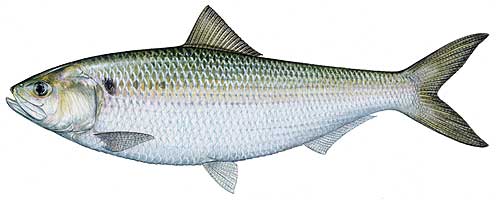American shad are the signature fish of the modern Columbia River, at least in terms of numbers. Salmon and steelhead once were among the most prolific fish in the river, but their numbers declined over time from annual runs of at least 10 million to 1-3 million or so today, in a good year. Shad, by comparison, routinely average that many, and in some years the number counted at Bonneville Dam is as high as 4-5 million (5.3 million in 2004, and 4.2 million in 2005, for example). The U.S. Geological Survey has estimated as many 10 million to 20 million adult shad may enter the Columbia annually — 4,000 metric tons (adults average 2-3 pounds). Most of the spawning, which occurs between May and July, is in the lower Columbia below Bonneville, but shad have migrated past Bonneville, The Dalles, John Day, McNary, and Priest Rapids dams on the Columbia and the four lower Snake River dams, according to the Survey.
Unlike salmon and steelhead, shad are not native to the Columbia. They were introduced to the Pacific Coast from the Atlantic coast by a man named Seth Green, one of the nation’s first and best-known fish culturists. Green planted 10,000 in the Sacramento River in 1871. Five years later shad were being captured in the Columbia River and in 1880 the shad invasion was confirmed by fish scientist David Starr Jordan, who sent a specimen to the Smithsonian Institution where it is preserved to this day.
Shad once were highly valued. In 1888, in their second annual report to the Governor, the Oregon Fish Commissioners commented that shad “. . . are becoming more plentiful each year in the Columbia River. They are the offspring of the fish planted in San Francisco Bay several years ago by the United States Fish Commission. They are an excellent food fish, and we would recommend that the small ones receive the same protection as salmon, and a few hundred thousand of these fish be procured and planted in the streams most suitable for them.”
Like salmon and steelhead, shad are anadromous. Biologically part of the herring family of fish, they spawn in the mainstem Columbia River primarily above Bonneville Dam and also in the Willamette River of Oregon. Shad go to the ocean as adults, returning to spawn when they are three to five years of age. The run peaks in June. Unlike salmon and steelhead, shad spawn in open water rather than laying eggs on gravel. Also unlike salmon, shad can make the round trip to the ocean several times and spawn additional generations.
Shad spawn prolifically, produce large numbers of smolts, and return as adults in such volume that they are fished both commercially and for sport. There is no daily limit on Columbia River shad in either Washington or Oregon. Shad are caught in the lower Snake River, but that is about as far inland as they go. The bulk of the annual run spawns downstream from McNary Dam. It’s not unusual for fishers to catch 20 to 30 shad per day.
Recreational fishing for Columbia River shad peaked in the early 1990s with more than 20,000 angler trips per year recorded by the Washington and Oregon fish and wildlife departments. While abundant, shad today are fished mainly for the pleasure of the sport, not necessarily as a food fish. Shad are bony; they can be filleted, but most fishers prefer to pickle or smoke them, or cook them in pressure cookers. Shad roe, however, is considered a delicacy.



